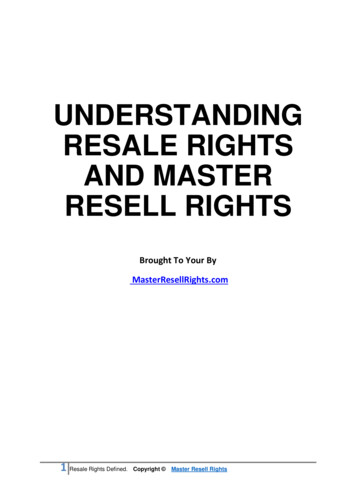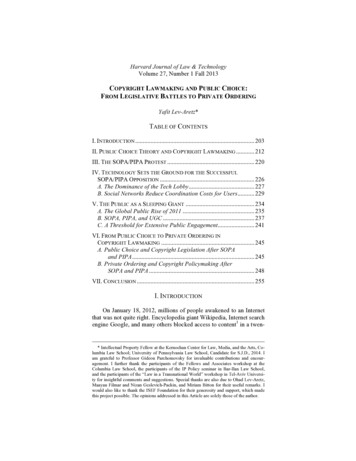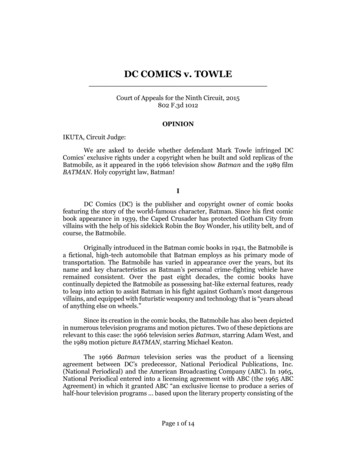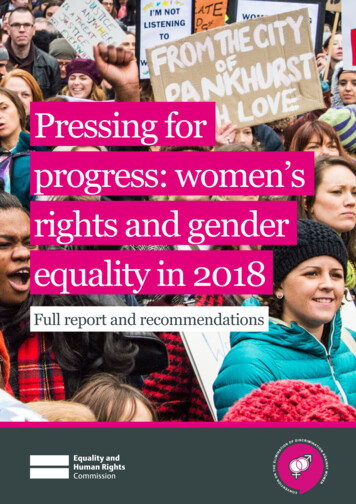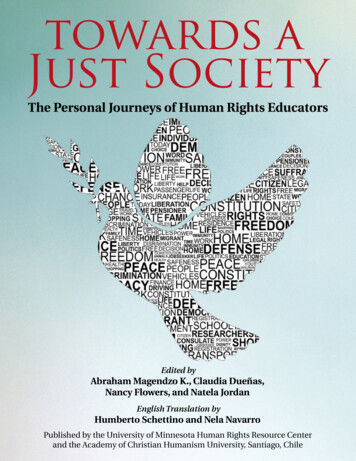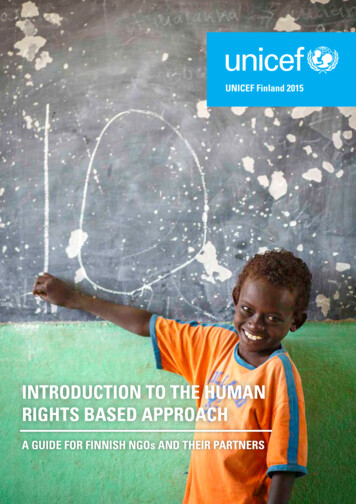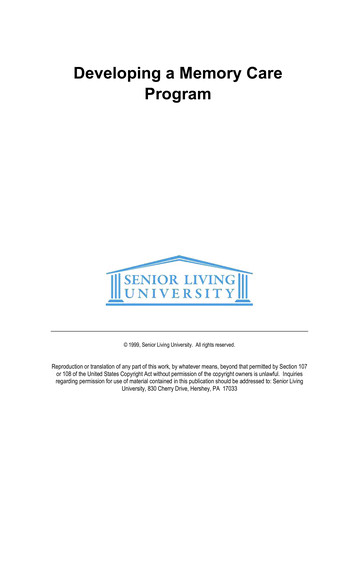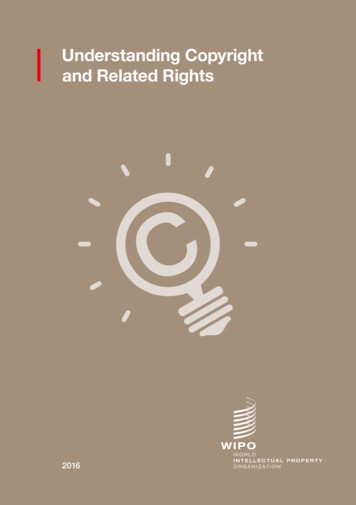
Transcription
Understanding Copyrightand Related Rights2016
Understanding Copyright and Related RightsThe user is allowed to reproduce, distribute, adapt, translateand publicly perform this publication, including for commercial purposes, without explicit permission, provided that thecontent is accompanied by an acknowledgement that WIPOis the source and that it is clearly indicated if changes weremade to the original content.Adaptation/translation/derivatives should not carry anyofficial emblem or logo, unless they have been approved andvalidated by WIPO. Please contact us via the WIPO websiteto obtain permission.For any derivative work, please include the following disclaimer: “The Secretariat of WIPO assumes no liability orresponsibility with regard to the transformation or translationof the original content.”When content published by WIPO, such as images, graphics,trademarks or logos, is attributed to a third-party, the userof such content is solely responsible for clearing the rightswith the right holder(s).To view a copy of this license, please visit e designations employed and the presentation of materialthroughout this publication do not imply the expression ofany opinion whatsoever on the part of WIPO concerning thelegal status of any country, territory or area or of its authorities,or concerning the delimitation of its frontiers or boundaries.This publication is not intended to reflect the views of theMember States or the WIPO Secretariat.The mention of specific companies or products of manufacturers does not imply that they are endorsed or recommendedby WIPO in preference to others of a similar nature that arenot mentioned. WIPO, 2016First published 2005Second edition 2016World Intellectual Property Organization34, chemin des Colombettes, P.O. Box 18CH-1211 Geneva 20, SwitzerlandISBN: 978-92-805-2799-5Attribution 3.0 IGO license(CC BY 3.0 IGO)Printed in Switzerland
Understanding Copyright and Related RightsContentsIntroductionIntellectual PropertyThe Two Branches of Intellectual PropertyWorks Protected by CopyrightRights Protected by CopyrightRights of reproduction, distribution,rental and importationRights of public performance, broadcasting,communication to the public and making availableto the publicTranslation and adaptation rightsMoral rightsLimitations and Exceptions to RightsDuration of CopyrightOwnership, Exercise and Transfer of CopyrightEnforcement of RightsRelated RightsThe Role of WIPOFurther Information1
Understanding Copyright and Related RightsIntroductionThis publication provides an introduction to copyright andrelated rights for non-specialists. It explains in general termsthe principles of copyright law and practice and describes thedifferent types of rights that copyright and related rights protect, as well as the limitations and exceptions to those rights.It also briefly covers transfer of copyright and provisions forenforcement.Detailed legal or administrative guidance on how copyrightoperates in a particular country is not covered here, but can beobtained from national intellectual property or copyright offices.The “Further Information” section also lists some useful WIPOwebsite links for readers seeking greater depth.A separate publication, Understanding Industrial Property,offers an equivalent introduction to the subject of industrialproperty, including patents for inventions, industrial designs,trademarks and geographical indications.A separate publication,Understanding IndustrialProperty, offers an equivalentintroduction to the subject ofindustrial property, includingpatents for inventions,industrial designs, trademarksand geographical indications.2
Understanding Copyright and Related RightsIntellectual PropertyCopyright legislation is part of the wider body of law known as intellectual property(IP) which refers broadly to the creations of the human mind. IP rights protect theinterests of innovators and creators by giving them rights over their creations.The Convention Establishing the WorldIntellectual Property Organization (1967)does not seek to define IP, but lists thefollowing as protected by IP rights: literary, artistic and scientific works; performances of performing artists,phonograms and broadcasts; inventions in all fields of human endeavor; scientific discoveries; industrial designs; trademarks, service marks, and commercial names and designations; protection against unfair competition;and “all other rights resulting from intellectual activity in the industrial, scientific,literary or artistic fields”.Countries generally have laws to protectIP for two main reasons: to give statutory expression to therights of creators and innovators intheir creations and innovations, balanced against the public interest inaccessing creations and innovations; to promote creativity and innovation,so contributing to economic and socialdevelopment.The importance of protecting IP was firstrecognized in the Paris Convention for theProtection of Industrial Property (1883)(Paris Convention) and the Berne Convention for the Protection of Literary andArtistic Works (1886) (Berne Convention).Both treaties are administered by theWorld Intellectual Property Organization(WIPO).3
Understanding Copyright and Related RightsThe Two Branches of Intellectual PropertyIP is usually divided into two branches, namely industrial property and copyright.Industrial propertyCopyrightIndustrial property takes a range of forms,including patents for inventions, industrialdesigns (aesthetic creations related tothe appearance of industrial products),trademarks, service marks, layout-designs of integrated circuits, commercialnames and designations, geographicalindications and protection against unfaircompetition.Copyright relates to literary and artisticcreations, such as books, music, paintings and sculptures, films and technology-based works (such as computerprograms and electronic databases). Incertain languages, copyright is referred toas authors’ rights. Although internationallaw has brought about some convergence,this distinction reflects an historic difference in the evolution of these rights that isstill reflected in many copyright systems.The expression copyright refers to the actof copying an original work which, in respect of literary and artistic creations, maybe done only by the author or with the author’s permission. The expression authors’rights refers to the creator of an artisticwork, its author, thus underlining that, asrecognized in most laws, authors havecertain specific rights in their creationsthat only they can exercise, which areoften referred to as moral rights, suchas the right to prevent distorted reproductions of the work. Other rights, such as theright to make copies, can be exercised bythird parties with the author’s permission,for example, by a publisher who obtains alicense to this effect from the author.4
Understanding Copyright and Related RightsWhile other types of IP also exist, it is helpful at this stage tothink of the distinction between industrial property and copyrightin terms of the basic difference between inventions and literaryor artistic works.Inventions may be defined in a non-legal sense as new solutionsto technical problems. These new solutions are ideas, and areprotected as such. Protection of inventions under patent lawdoes not require the invention to be represented in a physicalform. The protection accorded to inventors is, therefore, protection against any use of the invention without the permission of theowner. Even an inventor who independently creates somethingthat has already been invented, without copying or being awareof the first inventor’s work, must obtain permission in order toexploit the later invention.Copyright relates to literaryand artistic creations, suchas books, music, paintingsand sculptures, films andtechnology-based works(such as computer programsand electronic databases).5
Understanding Copyright and Related RightsUnlike protection for inventions, copyrightlaw and the associated concept of related or neighboring rights (discussed below) protects only the form of expressionof ideas, not the ideas themselves. Theworks protected by copyright are creativewith regard to the choice and arrangement of the medium of expression such aswords, musical notes, colors and shapes.Copyright protects the owner of the exclusive property rights against those whocopy or otherwise take and use the particular form in which the original workwas expressed. It is possible for authorsand creators to create, have rights in andexploit a work very similar to the creationof another author or creator without infringing copyright, as long as the work ofanother author or creator was not copied.From this basic difference between inventions and literary and artistic works, itfollows that the legal protection providedto each also differs. Since protection forinventions gives a monopoly right to exploit an idea, such protection is short induration – usually about 20 years. Thefact that the invention is protected mustalso be made known to the public. Thisinvolves issuing an official notificationthat a specific, fully described inventionis the property of a specific owner for afixed number of years. In other words, theprotected invention must be disclosedpublicly in an official register.6By contrast, the legal protection of literary and artistic works under copyrightprevents only unauthorized use of the expressions of ideas. This is one reason thatthe duration of protection for copyrightand related rights is much longer thanfor patents. Copyright law can be – andin most countries is – simply declaratory,i.e., the law may state that the author ofan original work has the right to preventother persons from copying or otherwiseusing the work. A created work is thusconsidered protected as soon as it exists,and a public register of copyright-protected works is not necessary. No actions orformalities are required of the author orcreator.
Understanding Copyright and Related RightsWorks Protected by CopyrightFor the purposes of copyright protection, the term “literary and artistic works” includes every original work of authorship, irrespective of its literary or artistic merit.The ideas in the work do not need to be original, but the form of expression must bean original creation by the author. Article 2 of the Berne Convention states that: “Theexpression ‘literary and artistic works’ shall include every production in the literary,scientific and artistic domain, whatever may be the mode or form of its expression.”The Convention lists the following examples of such works: books, pamphlets and other writings;lectures, addresses, sermons;dramatic or dramatico-musical works;choreographic works and entertainments in dumb show;musical compositions with or withoutwords;cinematographic works to which areassimilated works expressed by a process analogous to cinematography;works of drawing, painting, architecture, sculpture, engraving and lithography;photographic works to which are assimilated works expressed by a process analogous to photography;works of applied art;illustrations, maps, plans, sketchesand three-dimensional works relativeto geography, topography, architecture or science; “translations, adaptations, arrangements of music and other alterationsof a literary or artistic work,” which“shall be protected as original workswithout prejudice to the copyright inthe original work”; and “collections of literary or artistic workssuch as encyclopedias and anthologies which, by reason of the selectionand arrangement of their contents,constitute intellectual creations” –again, the Convention provides thatthese “shall be protected as such,without prejudice to the copyright ineach of the works forming part of suchcollections.”7
Understanding Copyright and Related RightsMember countries of the Berne Union and some other countriesprovide protection under their copyright laws for the abovecategories of works. However, the list is not intended to beexhaustive. Protection for some categories such as designsis optional. National copyright laws also protect other modesor forms of expression of works in the literary, scientific andartistic domain.Computer programs are a good example of a type of worknot included in the list in the Berne Convention, but that nowqualifies as a production in the literary, scientific and artisticdomain within the meaning of Article 2. Computer programsare protected under the copyright laws of a number of countries as well as under the WIPO Copyright Treaty (WCT) (1996).A computer program is a set of instructions that controls theoperations of a computer to enable it to perform a specific task,such as the storage and retrieval of information.The ideas in the work donot need to be original,but the form of expressionmust be an originalcreation by the author.8
Understanding Copyright and Related RightsRights Protectedby CopyrightCopyright protects two types of rights. Economic rights allowright owners to derive financial reward from the use of theirworks by others. Moral rights allow authors and creators totake certain actions to preserve and protect their link with theirwork. The author or creator may be the owner of the economic rights or those rights may be transferred to one or morecopyright owners. Many countries do not allow the transfer ofmoral rights.Economic rights allow rightowners to derive financialreward from the use of theirworks by others. Moral rightsallow authors and creatorsto take certain actions topreserve and protect theirlink with their work.9
Understanding Copyright and Related RightsEconomic rightsWith any kind of property, its owner may decide how it is to be used, and others canuse it lawfully only if they have the owner’s permission, often through a license. Theowner’s use of the property must, however, respect the legally recognized rights andinterests of other members of society. So the owner of a copyright-protected work maydecide how to use the work, and may prevent others from using it without permission.National laws usually grant copyright owners exclusive rights to allow third partiesto use their works, subject to the legally recognized rights and interests of others.Most copyright laws state that authors orother right owners have the right to authorize or prevent certain acts in relationto a work. Right owners can authorizeor prohibit: reproduction of the work in variousforms, such as printed publications orsound recordings; distribution of copies of the work; public performance of the work; broadcasting or other communicationof the work to the public; translation of the work into other languages; and adaptation of the work, such as turninga novel into a screenplay.The following section explains theserights in greater detail.10
Understanding Copyright and Related RightsRights of reproduction, distribution,rental and importationThe right of copyright owners to prevent others from making copies of their workswithout permission is the most basic right protected by copyright legislation. The rightto control the act of reproduction – be it the reproduction of books by a publisheror the manufacture by a record producer of compact discs containing recordedperformances of musical works – is the legal basis for many forms of exploitation ofprotected works.Other rights are recognized in nationallaws in order to ensure that this basicright of reproduction is respected. Manylaws include a right to authorize the distribution of copies of works. The right ofreproduction would be of little economicvalue if copyright owners could not control distribution of copies of their worksmade with their consent. The right of distribution usually terminates upon first saleor transfer of ownership of a particularphysical copy. This means, for example,that when the copyright owner of a booksells or otherwise transfers ownership ofa copy of the book, the owner of that copymay give the book away or even resellit without the copyright owner’s furtherpermission. The question of applying thisconcept to digital files is under consideration in various national legal systems.Another right that is gaining increasingrecognition, and is included in the WCT,is the right to authorize rental of copies of certain categories of works, suchas musical works in sound recordings,audiovisual works and computer programs. This became necessary in orderto prevent abuse of the copyright owner’sright of reproduction when technologicaladvances made it easy for rental shopcustomers to copy such works.Finally, some copyright laws include aright to control importation of copies as a means to prevent erosion of theprinciple of territoriality of copyright. Theright is based on the premise that thelegitimate economic interests of copyright owners would be endangered werethey not able to exercise their rights ofreproduction and distribution on a territorial basis.Certain forms of reproduction of a workare subject to exemptions from the general rule, because they do not requirethe permission of the right owner. Theseexemptions are known as limitations orexceptions to rights (see next section).11
Understanding Copyright and Related RightsRights of public performance, broadcasting,communication to the public and making availableto the publicA public performance is considered under many national laws to include any performance of a work at a place where the public is or can be present, or at a place notopen to the public but where a substantial number of persons outside the normal circleof a family and its close acquaintances are present. The right of public performanceentitles the author or other copyright owner to authorize live performances of a work,such as a play in a theatre or an orchestra performance of a symphony in a concerthall. Public performance also includes performance by means of a recording. Thus amusical work is considered publicly performed when a sound recording of that work,or phonogram, is played over amplification equipment, for example in a discotheque,airplane or shopping mall.The right of broadcasting covers thetransmission for public reception ofsounds, or of images and sounds, bywireless means, whether by radio, television or satellite. When a work is communicated to the public, a signal isdistributed by wire or wireless means forreception only by persons who possessthe equipment necessary to decode thesignal. Cable transmission is an exampleof communication to the public.Under the Berne Convention, authorshave the exclusive right to authorize thepublic performance, broadcasting andcommunication of their works to the public. Under some national laws, the exclusive right of the author or other right owner to authorize broadcasting is replaced,in certain circumstances, by a right toequitable remuneration, although thistype of limitation on the broadcastingright has become less common.12In recent years, the rights of broadcasting,public performance and communicationto the public have been the subject ofmuch debate. New questions have arisenas a result of technological developments,in particular digital technologies, whichhave introduced interactive communications that enable users to select works tobe delivered to their computers or otherdevices. Opinions diverge as to whichright should be applied to this activity.Article 8 of the WCT clarifies that it shouldbe covered by an exclusive right, whichthe Treaty describes as the authors’ rightto authorize the making available oftheir works to the public “in such away that members of the public can access these works from a place and at atime individually chosen by them”. Mostnational laws implement this right as apart of the right of communication to thepublic, although some do so as part ofthe right of distribution.
Understanding Copyright and Related RightsTranslation and adaptation rightsTranslating or adapting a work protectedby copyright also requires permissionfrom the right owner. Translation meansthe expression of a work in a languageother than that of the original version.Adaptation is generally understood as themodification of a work to create anotherwork, for example adapting a novel tomake a film, or the modification of a workfor different conditions of exploitation,e.g., by adapting a textbook originallywritten for university students to make itsuitable for a lower level.The scope of the right of adaptation hasbeen the subject of significant discussionin recent years because of the greatlyincreased possibilities for adapting andtransforming works in digital formats.With digital technologies, users can easilymanipulate text, sound and images tocreate user-generated content (UGC).Discussion has focused on achieving anappropriate balance between the rightsof the author to control the integrity ofa work by authorizing modifications,and the rights of users to make changes that seem to be part of the normalTranslations and adaptations are them- use of a work in digital format. Someselves works protected by copyright. In of the questions revolve around whethorder to publish a translation or adapta- er authorization from the right owner istion, permission must be obtained from needed to create new works that useboth the owner of the copyright in the parts of previously existing works, fororiginal work and the owner of copyright example through sampling or mash-ups.in the translation or adaptation.New questionshave arisen as aresult of digitaltechnologies13
Understanding Copyright and Related RightsMoral rightsThe Berne Convention, in Article 6bis,requires its members to grant authorsthe following rights:These and other similar rights grantedin national laws are generally known asthe moral rights of authors. The BerneConvention requires these rights to be(i) the right to claim authorship of a work independent of authors’ economic rights.(sometimes called the right of pater- Moral rights are only accorded to indinity or the right of attribution); andvidual authors and in many national laws(ii) the right to object to any distortion or they remain with the authors even aftermodification of a work, or other de- the authors have transferred their ecorogatory action in relation to a work, nomic rights. This means that even where,which would be prejudicial to the au- for example, a film producer or publisherthor’s honor or reputation (sometimes owns the economic rights in a work, incalled the right of integrity).many jurisdictions the individual authorcontinues to have moral rights.Moral rights are onlyaccorded to individualauthors and in manynational laws theyremain with the authorseven after the authorshave transferred theireconomic rights.14
Understanding Copyright and Related RightsLimitations andExceptions to RightsThere are several types of limitations and exceptions to copyright protection. First, certain categories of works are excludedfrom copyright protection. In some countries, works are excluded from protection if they are not fixed in a tangible form.For example, a work of choreography would only be protectedonce the movements were written down in dance notation orrecorded on videotape. In some countries, the texts of laws aswell as court and administrative decisions are excluded fromcopyright protection.Second, certain particular acts of exploitation that usuallyrequire the right owner’s permission may, under circumstances specified in the law, be carried out without the owner’spermission. The two basic types of limitations and exceptionsin this category are: (a) free use, which carries no obligationto compensate the right owner for the use of the work withoutpermission; and (b) non-voluntary (or compulsory) licenses,which require that compensation be paid to the right owner fornon-authorized exploitation.Certain categories ofworks are excluded fromcopyright protection.15
Understanding Copyright and Related RightsExamples of free use include: quoting from a protected work, provided that the source of the quotation andthe name of the author are mentioned,and that the extent of the quotation iscompatible with fair practice; use of works by way of illustration forteaching purposes; and use of works for the purpose of newsreporting.In respect of free use for reproduction,the Berne Convention contains a generalrule rather than an explicit limitation orexception. Article 9(2) states that memberstates may provide for free reproductionin certain special cases where that actdoes not conflict with the normal exploitation of a work and does not unreasonablyprejudice the legitimate interests of theauthor. For example, many national lawsallow individuals to reproduce a workexclusively for their personal, private andnon-commercial use. However, the easy,high-quality individual copying madepossible by digital technologies has ledsome countries to introduce systems(sometimes referred to as private copylevies) that allow private copying but incorporate a mechanism for payment toright owners for the resulting prejudiceto their economic interests.16In addition to the specific categories offree use set out in national laws, the lawsof many countries recognize the concepts of fair use or fair dealing. Thesebroad, general limitations or exceptionsallow the use of works without the rightowner’s permission, taking into accountfactors such as the nature and purposeof the use, including whether it is for commercial purposes; the nature of the workused; the amount of the work used inrelation to the work as a whole; and thelikely effect of the use on the potentialcommercial value of the work.The laws ofmany countriesrecognizethe conceptsof fair use orfair dealing.
Understanding Copyright and Related RightsNon-voluntary (compulsory) licenses allow the use of worksin certain circumstances without the right owner’s permission,but require that compensation be paid for that use. Such licenses are called non-voluntary because they are allowed within thelaw and do not result from the exercise of the exclusive rightof the copyright owner to authorize particular acts, and thusthey are not voluntary on the part of the copyright owner. Twonon-voluntary licenses recognized in the Berne Conventionallow the mechanical reproduction of musical works and broadcasting. Non-voluntary licenses have been created in nationalcopyright systems when a new technology for disseminatingworks to the public emerges, and have been explained basedon the concern of national legislators that right owners are hindering or might hinder the development of the new technologyby refusing to authorize use of their works. Once adopted, theselicenses sometimes remain in the law even after the technologyhas been in place for many years. In some countries, effectivealternatives now exist for making works available to the publicbased on right owners’ permission, including through the collective administration of rights.Non-voluntary(compulsory) licensesallow the use of works incertain circumstanceswithout the right owner’spermission, but requirethat compensation bepaid for that use.17
Understanding Copyright and Related RightsLimitations and exceptions have traditionally focused on national situations. However, the text of the first multilateral copyright instrument centered on limitations and exceptions, theMarrakesh Treaty to Facilitate Access to Published Works forPersons Who Are Blind, Visually Impaired, or Otherwise PrintDisabled (Marrakesh Treaty), was adopted by WIPO MemberStates in June 2013. The Marrakesh Treaty requires its members to adopt limitations and exceptions for the creation andcross-border transfer of certain published works in formatsaccessible to persons who are blind, visually impaired, or otherwise print disabled.The Marrakesh Treatyrequires its members to adoptlimitations and exceptionsfor the creation and crossborder transfer of certainpublished works in formatsaccessible to persons who areblind, visually impaired, orotherwise print disabled.18
Understanding Copyright and Related RightsDuration of CopyrightCopyright protection does not continueindefinitely. Copyright laws provide for aperiod of time during which the rights ofthe copyright owner exist and may beexploited. The period or duration of copyright begins from the moment the workis created or, under some national laws,when it is expressed or “fixed” in tangible form. Copyright protection continues,in general, until a certain time after thedeath of the author. The purpose of thisprovision in the law is to enable the author’s successors to benefit economicallyfrom exploitation of the work even afterthe author’s death. In some countriesmoral rights continue in perpetuity afterthe end of the term of economic rights.In countries party to the Berne Convention and some other countries, the duration of copyright provided in national lawis, as a general rule, the life of the authorplus not less than 50 years after the author’s death. There is a trend in a numberof countries to lengthen the duration ofcopyright to the life of the author plus 70years after the author’s death. The BerneConvention and many national laws alsoestablish periods of protection for workssuch as anonymous, posthumous andcinematographic works where it is notpossible to base duration on the life ofan individual author.Works that are no longer subject to copyright protection enter the public domain.The duration of copyrightbegins from the moment thework is created or, undersome national laws, when itis “fixed” in tangible form.Copyright protection continues,in general, until a certain timeafter the death of the author.19
Understanding Copyright and Related RightsOwnership, Exercise andTransfer of CopyrightThe owner of copyright in a work is generally, at least in the first instance, thecreator of a work, i.e., the author. However, this is not always the case. The BerneConvention, in Article 14bis,
A separate publication, Understanding Industrial Property, offers an equivalent introduction to the subject of industrial property, including patents for inventions, industrial designs, trademarks and geographical indications. A separate publication, Understanding Industrial Property, offers an equivalent introduction to the subject of

